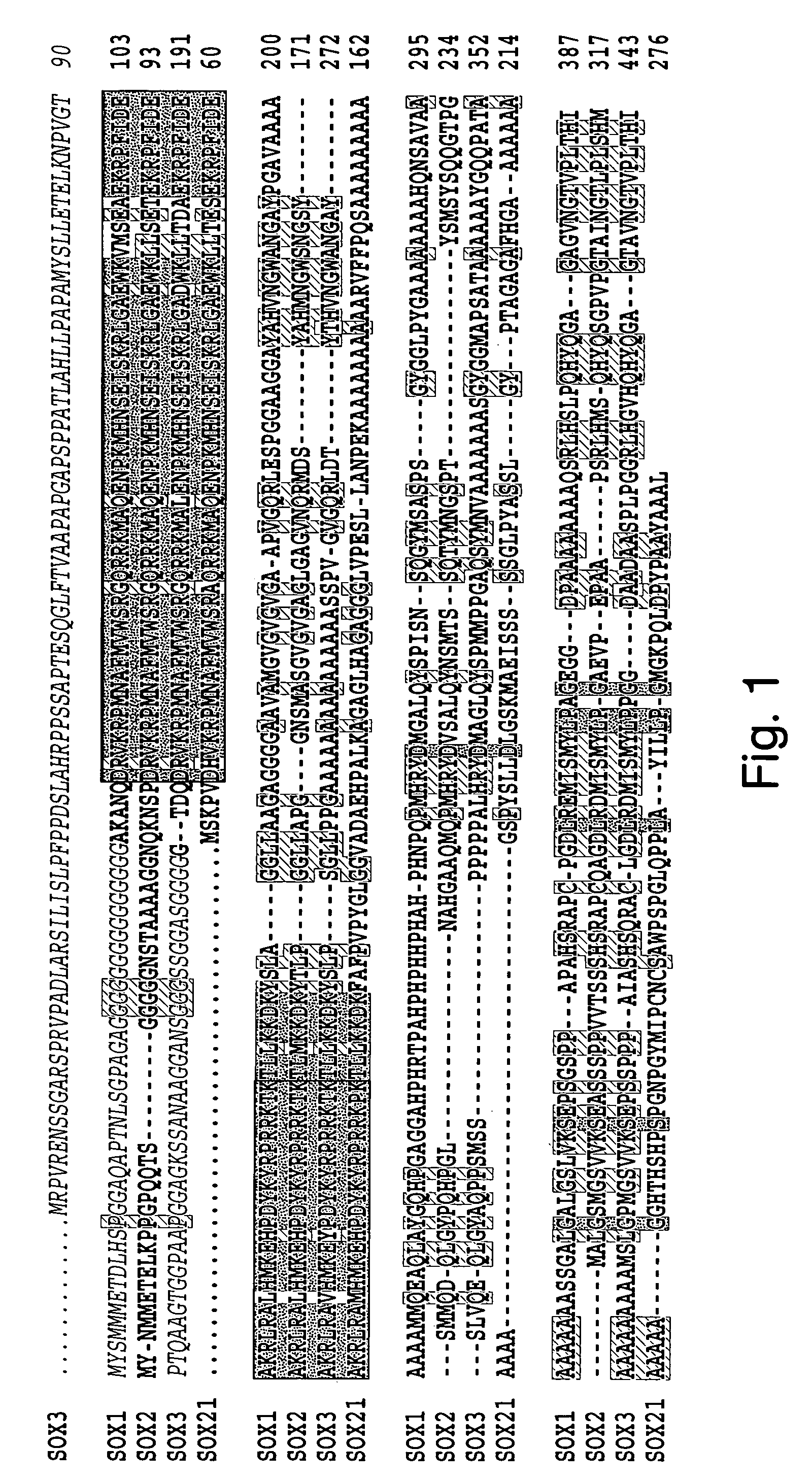Small cell lung cancer associated antigens and uses therefor
a technology of antigens and small cells, applied in the field of nucleic acids and encoded polypeptides, can solve problems such as resistance to the approach
- Summary
- Abstract
- Description
- Claims
- Application Information
AI Technical Summary
Benefits of technology
Problems solved by technology
Method used
Image
Examples
example 1
Isolation of Immunoreactive Clones from SCLC Cell Lines by SEREX
[0205]SEREX analysis of the SCLC cell line NCI-H740 with a pool of five sera from SCLC patients at 1:103 dilution resulted in the isolation of 37 clones coding for 8 known gene products (Table 1a). These eight genes were given SEREX gene designations of NIVY-SCLC-1 to NY-SCLC-8.
[0206]
TABLE 1aGenes isolated by SEREX analysis of thesmall cell lung cancer cell line NCI-H740SEQ IDGeneGene / Sequence IdentityNumber of clonesNO:Designation[GenBank Accession No.](% of total)3NY-SCLC-1SOX2 [Z31560]19 (51%)4NY-SCLC-2SOX1 [Y13436] 1 (3%)5NY-SCLC-3ZIC2 [AF104902] 9 (24%)6NY-SCLC-4ID4 [U28368] 2 (5%)7NY-SCLC-5MAZ [M94046] 1 (3%)8NY-SCLC-6MPP11 [X98260] 3 (8%)9NY-SCLC-7eIF2B [U23028] 1 (3%)10NY-SCLC-8RBP-1 [L07872] 1 (3%)Total:37
[0207]The most frequently isolated genes were SOX2 and ZIC2, comprising 51% and 24% of all clones. A single clone corresponding to SOX1 was also isolated from this library. SOX- and ZIC2-encoding clones showed...
example 2
Immunodominant Epitopes of ZIC2 and the SOX Proteins
[0211]Of 11 ZIC2 clones isolated, 7 clones were sequenced and 4 were evaluated by restriction mapping. The longest ZIC2 clone (NCI-H740 #32) was ˜2.6 kb, the sequence of which extends beyond both 5′ and 3′ sequences of the ZIC2 cDNA entry in the GenBank (AF104902). The shortest clone (NCI-H740 #41) migrated as a ˜1 kb band on agarose gels and its 5′ end corresponded to nucleotide position 692 (amino acid residue 231) of AF104902. Reactivity of this clone with SCLC sera was comparable to other larger clones. As the intensity of the reactivity of this shorter clone was comparable to that of other larger ZIC2 clones, the seroreactive epitope(s) of ZIC2 polypeptide (SEQ ID NO:22) reside between amino acid residue 231 and the C-terminal end (amino acid residue 533).
[0212]Of the 24 SOX genes, 8 SOX2 clones and the SOX1, SOX3 and SOX21 clones were sequence analyzed while the remaining 13 SOX2 clones were analyzed and confirmed by restrict...
example 3
ZIC2 is Expressed Exclusively in Brain, Testis and Tumors
[0213]ZIC2 gene expression was analyzed by RT-PCR. The RNA quality was confirmed by successful amplification of p53 exons 5 and 6. Among normal tissues ZIC2 mRNA was only detectable in brain and to a lesser extent in testis but not in skin, kidney, small intestine, pancreas, uterus and lung. Of 11 SCLC cell lines analyzed, all 9 classical SCLC lines (SK-LC-13, NCI-H69, -H128, -H146, -H187, -H209, -H378, -H889, -H740) had detectable ZIC2 mRNA while two variant SCLC cell lines (NCI-H82 and NCI-H526) showed no or minimal expression. Among other cell lines, ZIC2 mRNA could be amplified in 100% ( 7 / 7) of non-small cell lung tumor cell lines and 83% ( 10 / 12) of melanoma cell lines (Table 2). Among tumor tissues, 50% ( 5 / 10) of melanoma, 50% ( 2 / 4) of colon cancer, 75% (¾) of breast cancer, 86% ( 12 / 14) of head and neck cancer, 66% ( 6 / 9) of lung cancer, 50% ( 7 / 14) of transitional cancer, 50% (½) of leiomyosarcoma and 100% ( 2 / 2) of...
PUM
| Property | Measurement | Unit |
|---|---|---|
| Cytotoxicity | aaaaa | aaaaa |
Abstract
Description
Claims
Application Information
 Login to View More
Login to View More - R&D
- Intellectual Property
- Life Sciences
- Materials
- Tech Scout
- Unparalleled Data Quality
- Higher Quality Content
- 60% Fewer Hallucinations
Browse by: Latest US Patents, China's latest patents, Technical Efficacy Thesaurus, Application Domain, Technology Topic, Popular Technical Reports.
© 2025 PatSnap. All rights reserved.Legal|Privacy policy|Modern Slavery Act Transparency Statement|Sitemap|About US| Contact US: help@patsnap.com

